Never the same galaxy twice
Welcome to Galactic Civilizations IV! You are in for a treat. If you’ve never played a space “4X” strategy game before, then good news: this is a great one to start with. If you are coming from Galactic Civilizations III or one of the strategy games made by our friends at Paradox, or Mohawk, or Firaxis, then you are probably going to like Galactic Civilizations IV.
Since Galactic Civilizations III, we have had the opportunity to talk with fans, review feedback made about other games, and apply the lessons learned to Galactic Civilizations IV. For us at Stardock, GalCiv IV is a bit of a reunion as it brings back the GalCiv II team who were working on other things during the development of GalCiv III. We are very excited for you to play the game. Hopefully this guide will make it a bit easier.
What’s new:
Here's a high level summary of the new features and what they are meant to do:
- Sectors. These are maps that connect to other maps. This feature dramatically improves pacing, letting us have much bigger maps (because let’s face it, 200 tiles of dead space is not fun to traverse).
- Characters. This will be the most obvious first turn change for players. Less spreadsheety, more nuance.
- Policies. Our stats show that the vast majority of people play as the Terran Alliance. Not even a custom civ. Sigh. So we need a way to allow players to customize their civ during the game. Once you use this feature, you’ll never want to go back.
- Prestige Victory. 4X games are notorious for knowing you’re going to win long before you actually win. The Prestige counter - combined with the new Galactic Achievements feature - allows you to move the game to the endgame quickly.
- Executive Orders. GalCiv IV introduces a new resource called “Control” that allows players to perform direct actions on the game. These actions can have consequences, but allow players more direct ways to intervene.
- Core worlds. A big issue in 4X games is the micro-management in the late game. In every GalCiv playthrough, later in the game the player might have dozens of planets to manage (just like in other 4X games where you might have dozens of cities or stars or whatever). GalCiv IV has core worlds, which are high quality worlds that matter. Those are fed by colonies, which require no management. So late game, the player might have 50 worlds in their civilization, but only 9 of them are core worlds.
- Combat. Battles (and invasions) are no longer always over in a single turn. An invasion might take several turns to occur. Transports are only required for core worlds, whereas colonies can be taken by any ship with weapons. Battles can also take place across multiple tiles, allowing for ships with extreme range weapons to soften up targets from multiple tiles away.
- Missions. We eliminated “the campaign” and instead took the content and made it so that every game can feel like a campaign with “missions,” which are story driven quests based on who you are playing as, who you are playing against, and what characters are in your civilization.
- Ideology. Gone is the old “good” vs. “neutral” vs. “evil”. Now there are 7 categories of ideology, each with two trees. The choices players face are no longer “I’m a good person vs. I’m a terrible being," but instead are things like cooperation vs. creativity, or innovation vs. tradition, or compassion vs. pragmatism.
- New Economic System. In the new system, resources are brought in from the worlds themselves and then multiplied (as a %) by the population who are empowered (again by a %) by the improvements on the planet. The approval rating on a planet directly affects production (which makes approval matter a lot) with new elements such as crime (which affects planetary income) and pollution (which affects food production) as additional potential casualties of player decisions. Finally, approval is now extremely nuanced and explained in great detail.
Getting Started
When you load up the game, you will see a number of options:

For those of you interested in modding, check out the bottom row of buttons. The extra focus on modders for GalCiv IV will come as no surprise when you learn that the gamer's lead designer is Derek “Kael” Paxton, the mind behind the Civilization IV mod, “Fall from Heaven”. But for this walkthrough, we’re going to stick a fresh new regular game.
Who are you?
This time around not only do we include more than twice as many default civilizations to choose from (with differences between them that are bigger than ever before), but we also included updated content that originally appears in in DLC for previous GalCiv games:

But, for today: CHOOSE the Terrans.

Go ahead and leave the defaults in for the next screens:

Your opponents
There is no perfect setup here. Pick a bunch of peace loving space hippies if you want a peaceful game. You can mouse over to see what their personalities are like and pick based on what you want. Or, you can roll the dice and go with random players.

And so it begins
The year is 2307. Earth is united. The humans have recently discovered a technology called Hyperdrive, which allows for faster than light (FTL) travel by individual ships and have rushed to build three starships:

The first ship, the T.A.S. (Terran Alliance Starship) Discovery is a survey ship designed to explore the various anomalies that are quickly being discovered.
The second ship, the T.A.S. Endeavour, is a colony ship that was built with Mars in mind but, you know, it’s your call.
Lastly, there is the Theia, a probe with unlimited range that you can send out to explore.
Giving orders
Selecting something on the map will bring up its order card. To order the Discovery to go survey, just click on the Survey button and it will automatically go do that.

You can also typically double click on objects to get to their details.

For example, if you double click on the Discovery you can not only see what components are on the ship, but sometimes the company that manufactured the technology being used.
Your first move
Go ahead and send the Endeavour to Mars.
The shipyard screen
Orbiting Earth is the largest manmade object in history: a shipyard called “The Forge”. This game doesn’t get into the scandals and controversy of its making (well, it might via events). Suffice to say, there was a lot of graft. Anyway, the shipyard makes ships.

At first there are really only two types of ships you can make: colony ships and probes. Which one you start with is really a tough call. I’m glad I’m not you. I don’t want to be hauled in front of the Senate to answer why I chose a colony ship over a probe. My hands are clean.
Colony ships require a citizen (population) which means that if you choose that, your production will go down. On the other hand, colony ships can colonize planets.
Probes are good for quickly finding the good planets. It is, after all, a space race out there and finding the good planets quickly matters.
I am going to choose a probe.
I am also going to choose to “rush buy it”

Rushing costs money - a lot of money. But, you get the probe on the next turn instead of having to wait.
Your first policy
You can set the overall priorities for your entire civilization from the policy screen. It is shocking to believe that we didn’t think of this idea until GalCiv IV. Before, we had a few sliders and that was it.

Here, you can set your tax rate. The higher the taxes, the angrier people get. Happy people are productive people. Your civilization’s production is literally multiplied by your approval rating, so try not to make them too unhappy.
Now, which policy to pick? Again, senate hearings, blah blah. It’s tough. Different civilizations have different policies to choose from. I’m going to choose Fast exploration:

Getting 2 more moves is great, and who cares if my ships get a 50% HP hit? The galaxy is a peaceful utopia with no danger.
Researching Technology
Technology choices are the expression of the player’s strategy.

The game gives you up to 5 (starting with 4) techs that your civilization already has an idea on. The cost of these techs to research is discounted. But you don’t have to choose these:

You can choose a new set in a particular area. However, if you do this, you lose the 10% discount on tech.
In this game, I’m going to choose Starbases:

This tech not only unlocks the ability to construct starbases (of course), but it also gives you two free Constructors to start with. Techs giving you "free samples" is new to GalCiv IV and greatly helps with pacing.
Meanwhile on Earth
As planets go, Earth isn’t the worst one I’ve been on…

You can almost make out the shapes of the continents. Every planet has a “class”. The bigger the number, the better. Earth is a class 28. This means it has 28 tiles you can use to customize.
Earth is a CORE world which means you directly manage it.
CORE WORLDS vs. COLONIES
Unlike in previous GalCiv games where you would end up micro-managing 100+ planets, we instead split the concept between CORE WORLDS and COLONIES. We also made it so that core worlds were a lot more impactful. So late game, you might “only” have a dozen core worlds, but they’re interesting. Colonies, you don’t bother to manage. They simply feed their closest core world with minerals, tech, wealth, food, and culture.

This is who is governing the planet. Since this is Earth, that’s you. You are, we hope, 100% loyal to yourself. That’s what the 100 means.
The lower the loyalty, the more likely you’re going to get an ugly dice roll with that governor doing something you don’t want (like rebelling, taking all that core world’s colonies with them, and forming a new empire).
Governors also have stories. Each story has a tiny (but non-zero) chance of triggering an event in the game that relates to it.

Your worlds have 6 stats that the governor has to deal with:
- Pollution, which reduces food production.
- Crime, which reduces wealth.
- Control per turn, which is a new resource that lets you do great things galactically (we’ll talk about that in a sec).
- Approval, which is what % of your population like you.
- Maintenance, which is the upkeep cost of the planet.
- Resistance, which is a % cost to how long it would take an enemy to invade this planet. For instance, if it normally would take 10 turns to invade Earth, this 20% resistance means it would take 12 turns instead, giving you a bit more time to break the siege.

Planets have inputs. These inputs come from the planet itself, colonies, and elsewhere.
The inputs are: Minerals, Tech, Wealth, Farming, Influence.
Your citizens, empowered by the improvements you make to your planet, then take those inputs and increase it, or waste some of it.
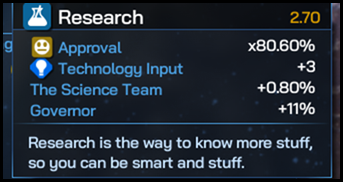
Research output = 3 tech coming in with an 80% approval, plus an 11.8% boost. This gets you to 2.7 research output.
Improvements
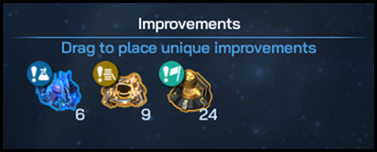
Then you have your unique improvements. Different types of terrain on the planet give differing bonuses. Keep in mind the adjacency bonuses:
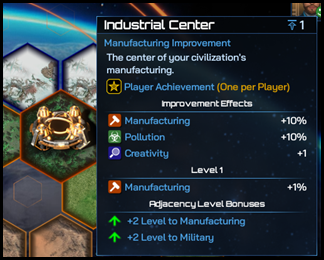
I put an industrial center down in a forest which gives it a +1 level bonus.
Then I queue up manufacturing districts around it:
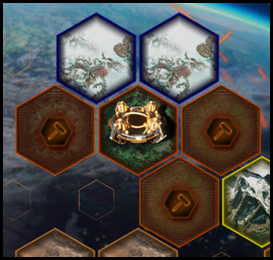
These will feed each other:
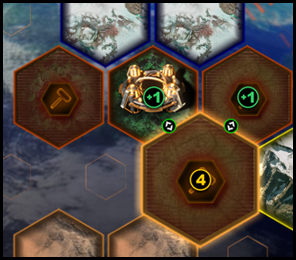
Resulting in a lot more production from the planet.
After rush building that industrial center, I now have:
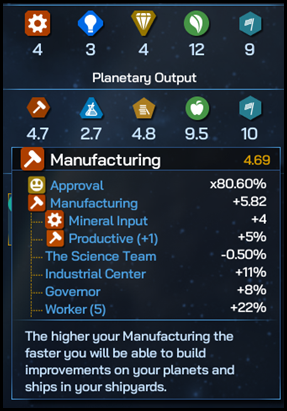
4.7 (instead of 4.3) industrial output per turn.
Let’s talk approval and citizens
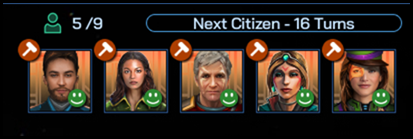
Your population is represented by citizens. You gain a new citizen every N turns (months). When you build a colony ship or a constructor or a transport, you have to use one of these citizens, which reduces the output of the planet.
Each person is different.
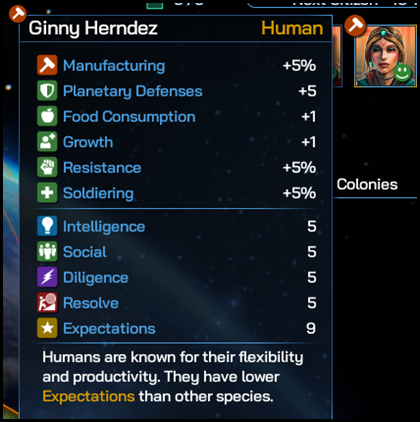
As a practical matter, they are similar enough that most of us won’t bother caring that much. But for min/maxers or people who are trying to win at really high difficulties where they need every bit of production, they can get into this.
The smiley face under them indicates their approval:
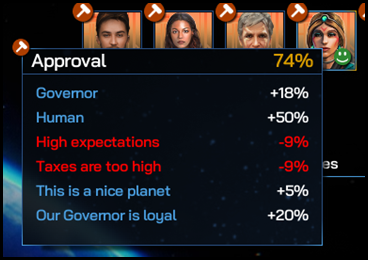
Ginny here represents a group that only has a 74% approval for you. Each one is a little different based on what traits they might have. Some can even be criminals who increase crime and cause trouble.
Do you know what you should do with criminals? Send them to a colony! Or exile them to a starbase - er, I mean, give them the opportunity to manage a starbase.
Leaders
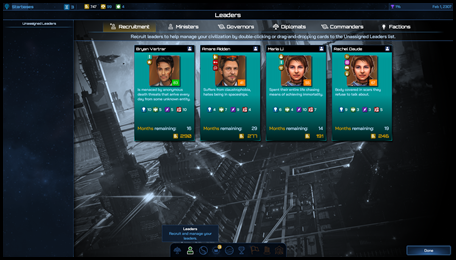
Leaders are a special type of citizen that you can recruit and give a specific job.
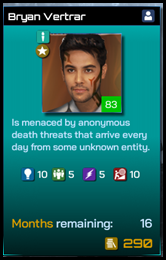
Leaders have stats just like any other citizen - but, unlike with regular citizens, these stats can really matter depending on the job you give them. They also cost money to recruit, have a loyalty stat, and some other traits to keep in mind.
Also: don’t forget that a story is attached to each of these people so if someone has a really shady past, you may want to skip them. Remember, if someone is too good to be true…
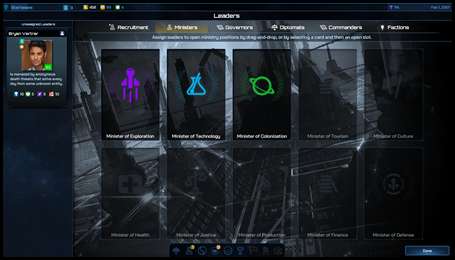
So, we hired Bryan. I picked him because he has a 10 intelligence.
If I make him minister of technology, he gives me a 10% bonus to research and unlocks the 5th slot on the research screen.
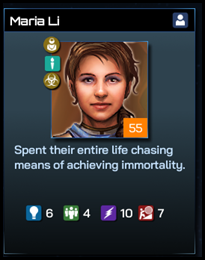
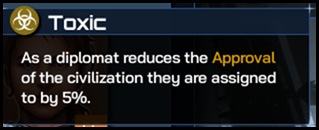
I also recruited Maria. However, see the little toxic icon? Let’s just say, don’t make her a diplomat. She is, however, very diligent.
Tip: Note the color coding. Purple positions go with purple stats.
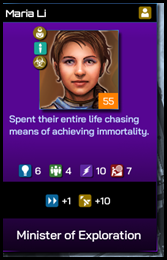
Now my ships get +1 moves and +10 more tiles.
I can’t afford any more leaders yet, so we’ll come back later.
Mars
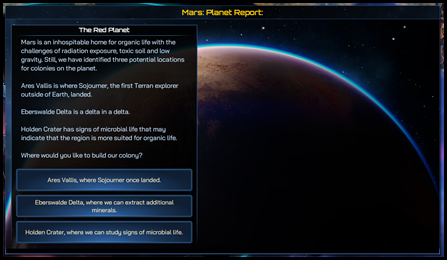
So the Endeavour has reached Mars. Great! This has brought up an event.
Each choice gives you a different bonus - and to be honest, they’re all good.

But, I’m going to pick getting a leader.
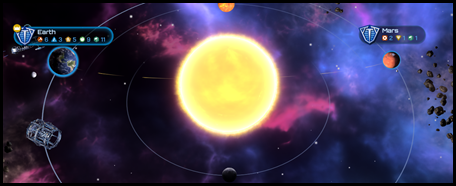

Now, Mars is just a colony. There’s nothing to manage. It sends back 2 minerals, 1 wealth and 1 influence back to Earth, which now become an input.
Commanders
After the next turn passes, the leader I got from Mars arrives.
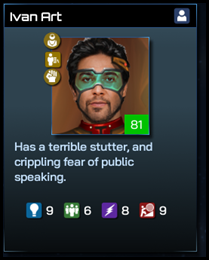
He’s’ great. Really. Like, I am going to save this game and play it later because whoa! But for now, I’m going to go to the commanders page:
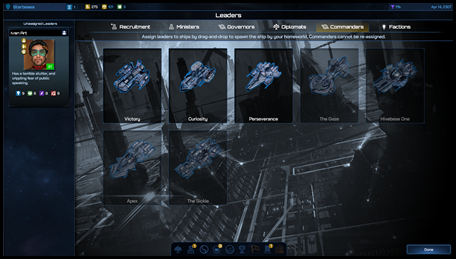
You can assign leaders to be in charge of a ship. Each civilization has their own ships and each ship uses the traits of a leader differently.
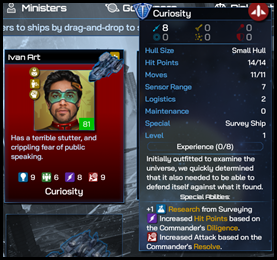
So I put Ivan in charge of the Curiosity, a powerful survey ship.
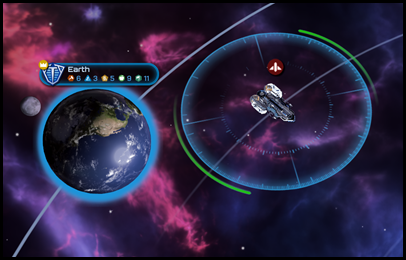
Executive Orders
Meanwhile, space Clippy is suggesting I show you executive orders. FINE.
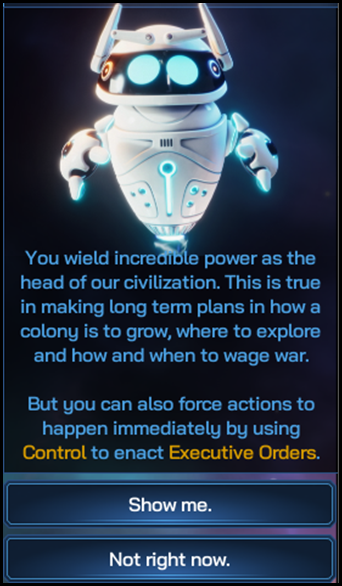
Believe it or not, this is the first GalCiv game to have an in-game tutorial like this (or even advisors). Yes, we are embarrassed.

Executive orders are super fun. You spend control and can do some cool things. You unlock more orders as you gain new techs.
Here, I’m going to order the civilian telescope people to let me use the telescope to peak at a nearby star.
I firmly believe that by the 24th century we will have the ability, using telescopes, to see planets in orbit of other stars…<cough>.

So I zoomed out and selected a nearby star. I can see it’s infested with pirates, which means don’t send ships over there until they have weapons.
Starbases
Soon I have the starbase tech. So it’s time to place starbases.
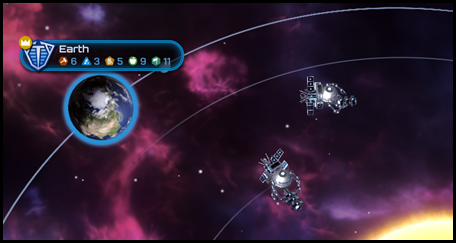
A constructor can transform into a starbase and grab/buff things within its area. When you click on one, you can see the circle in question.
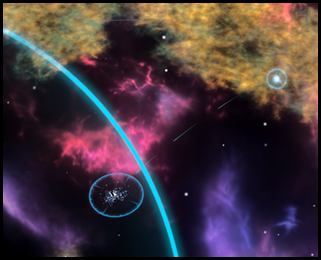
When you get near enough to a galactic relic or resource, a faint line will flow into it, indicating that it is in range.
There are 5 types of resources in this game:
- Durantium. This is needed for elite manufacturing efforts.
- Promethion. This is needed for elite research efforts.
- Elerium. This powers beam weapons.
- Anti-Matter. This powers missile weapons.
- Thulium. This powers mass driver weapons.
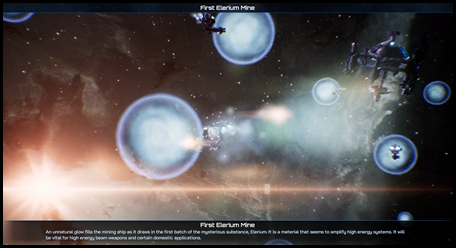
The starbase screen will let you spend starbase modules to upgrade the starbase further.
Starbase modules have to be constructed by shipyards, but various techs will give you some free ones.
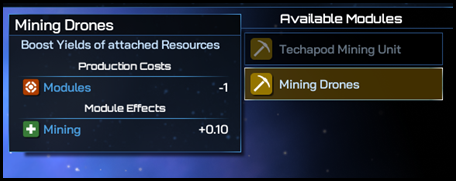
For example: Mining Drones costs 1 module but increases the mining output of the starbase by 0.1 per turn. When you research plasma beams or what have you, 1 plasma weapons module might cost 1 full elerium. If you don’t have Elerium you have to use the cheap, crappy budget beam weapons instead if you want a beam weapon on your ship.
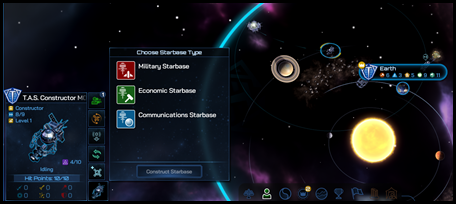
You can also assign a starbase where a core world is in its range. In this case, not only is a core world (Earth) in range, but there is an Ascension Crystal in range too.
Prestige Victory
Galactic Civilizations IV introduces a new type of victory condition: Prestige. This is, in hindsight, an obvious type of victory condition. Prestige = “Yea, you’re going to win anyway so we’re not going to force you to play 300 more turns to grind out a diplomatic victory or build the super space ship victory”.
How close you are to winning appears at the top:

Now, the good news is that, as a practical matter, the AI players can’t really achieve this particular type of victory. Neither can you without complete a Galactic Challenge. I’m not saying it’s not impossible to get to 1000 prestige points otherwise - it’s just very hard. So what are Galactic Challenges?
Galactic Challenges
GalCiv IV doesn’t include a campaign. Instead, we put all that time and effort into the galactic challenges. These are story based “quests” that are very difficult to win unless you are already winning.

This is probably one of the game’s “killer features” because they’re both fun to do and they give you a bunch of prestige points.
Thus, if you already are “winning” and have 800 prestige points, completing one of these might give you enough points to get you over the top instead of having to grind out hundreds of turns to finish. It offers the player a satisfying way to win the game.
Sending out the undesirables - er, heroic! - colonists
When you construct something that requires a citizen, you will see this:
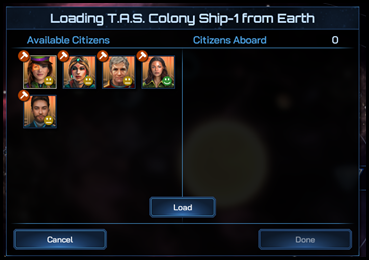
Now, everyone has their own strategy for this. For me, I usually put whoever is the unhappiest on the ship. Earth not good enough for ya? Huh? Think you’re too good? Well, we’re going to send you here:
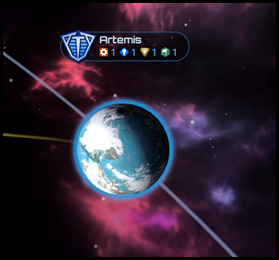
The frozen world of Artemis that is the 10th planet of our solar system (discovered in 2055). Enjoy.
Ideology
In GalCiv IV, there is a difference between KNOWING good and evil and actually DOING good and evil. You gain ideological awareness from various events. Then, by accomplishing quests you get CULTURE points to spend to actually adopt one of these ideologies.
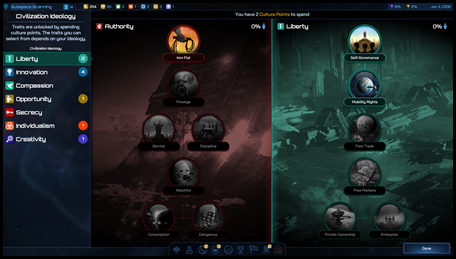
The left side tells you how much awareness you have in your leading area.
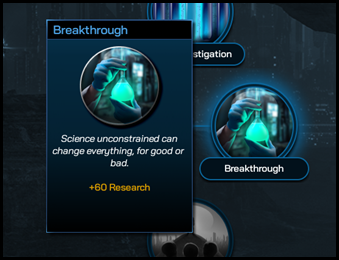
So here I’m going a culture point to get 60 research.
And the other on Efficiency:
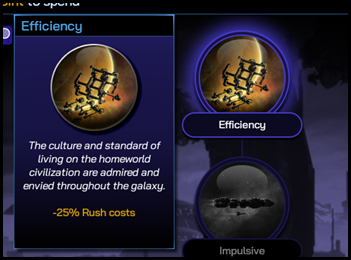
25% discount on rush costs is amazing early game.
Diplomacy
We’re not alone in the universe. That’s implied by the game’s title. Lurking in the dark forest of the galaxy are many other civilizations. The game supports something like 128 different civs (you’ll need to create or download additional ones if you want to play with more than the 18 we include).
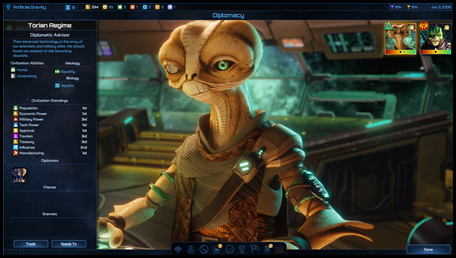
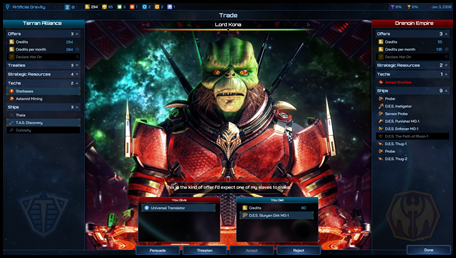
The bartering is pretty straightforward. There is a bar on how the other side values the trade.

You can also persuade or threaten them.

This should generally not be used unless it’s really important.
Zooming out
Using your mouse wheel, you can zoom out:

You can tell that there are two really really good planets over there on the bottom right. There is also a class 2 planet next to it. You will want to get good planets like those if you can.
You can also see that there are various resources over on the right: Durantium, and there are also a couple of relics. Which one you should go for first is a tough one. I would probably grab those class 30+ planets; they are so rare that, again, I’m going to be saving this game to play later.
Getting Governors
Rule of thumb: if the planet is less than, say, a class 20, don’t bother putting a governor on it. If you wouldn’t want to personally live on that planet, don’t assign a governor to it.
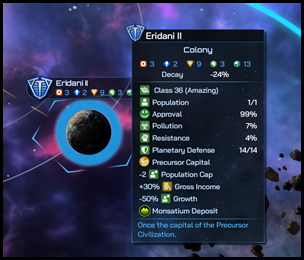
So here is Eridani II. This is a really, really good planet. But right now, it’s just a colony. A really good colony, mind, but still just a colony.
You can assign a leader to be a governor. We include a handy quick hire UI here too because we’re lazy.
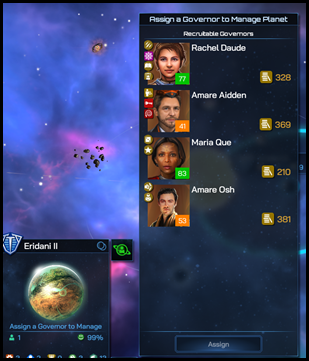
Make a note: If they aren’t loyal leaders, don’t assign them to run a powerful, super magical planet.
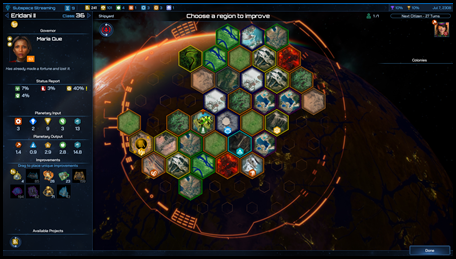
So we hired Maria Que and put her in charge. She is awesome.
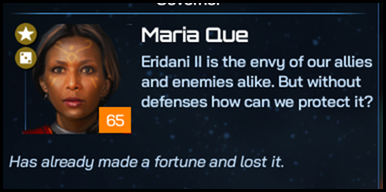

Unfortunately, our approval is low. We can do a number of things about that, including, - sigh - lowering taxes. This is why we can’t have nice things. But this planet, once it is built up, will be very important.
You will also want to build a shipyard once you get it producing at a decent clip:
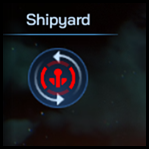
Getting to know the galaxy
Now, each civilization has its own story as well.
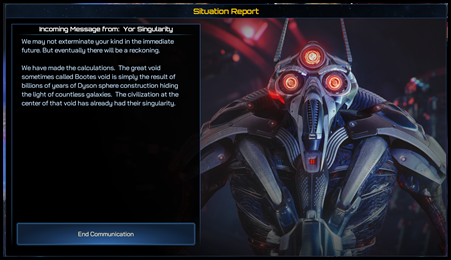
They will hint at it during the course of the game, which may (but probably won’t) trigger an event that relates to it. The Yor, for instance, are very concerned about the Bootes void.
Subspace Streams
Probably the most obvious big new feature of this game are the Subspace Streams.
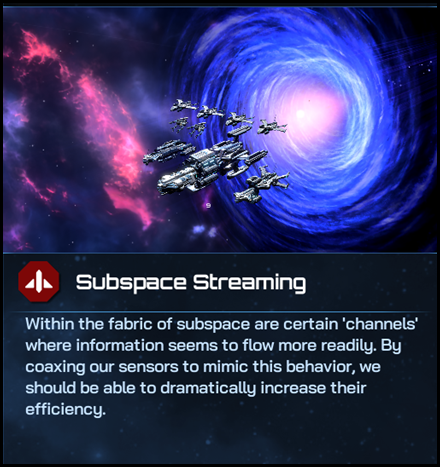
Historically, there’s been two types of games: the games that navigate like Master of Orion where ships move between star systems…and Civ style, where there’s a single free-form map.
Galactic Civilizations IV does both. It has a series of free form maps called SECTORS. A given sector can by tiny or huge depending on how the player set up the game.
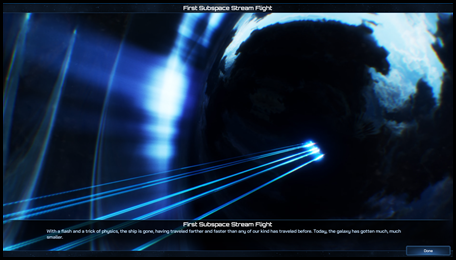
It requires a decent amount of research to get the tech to go to other sectors. This creates an additional exploration stage for the game.
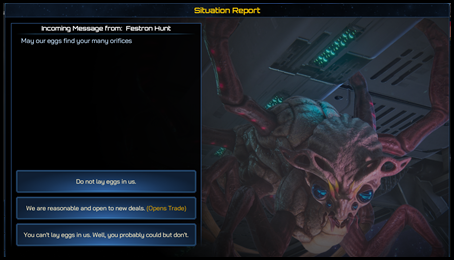
Other sectors will be filled with friendly, awesome, and generous aliens who clearly want nothing but the best for you.
If you zoom out far enough, you can see which sectors you’ve explored:
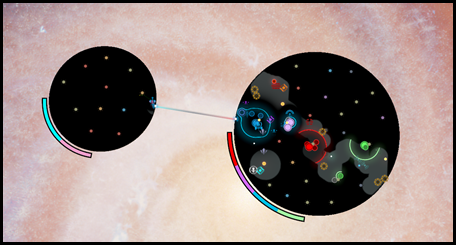
The color bar indicates how much influence each civ has in that sector. Controlling a sector gives the player a lot of prestige points.
The nice thing about sectors is that they create an extra dimension of distance. Whereas before there was only an X,Y distance, now there is, in effect, a Z distance because a sector might be “close” from a pure X,Y point of view, they could be very far away if it takes 5 sector jumps to get there.
Players can set up the game with only a single sector, or lots of sectors of varying sizes.
Warfare
Combat in Galactic Civilizations games are fairly straightforward. However, for GalCiv IV we’ve introduced the AAR report which is designed to give a bit more detail than previous games. In addition, ships can be upgraded to shoot from multiple tiles away.
Combat also no longer necessarily ends in a single turn. Only a handful of rounds occur in a single engagement, meaning that if there are surviving ships after a given round, they can try to retreat or continue the battle.
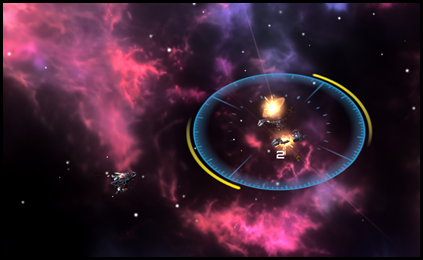
Players can also view the combat to see how their ships did against the enemy’s defenses.
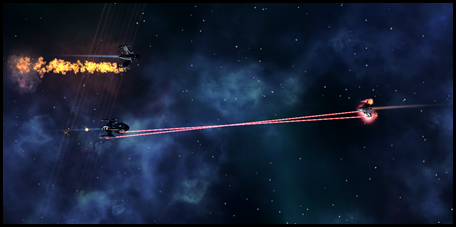
So in this case I was defeated:
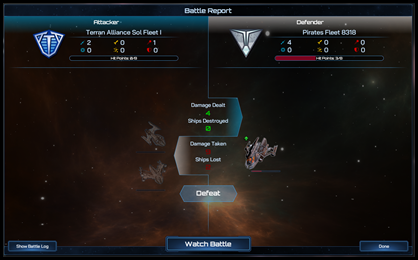
That’s because the pirate fleet was a single ship with 8 HP where as my fleet was 2 ships each with only 4 HP. Even if the weapons were equal (and they weren’t), a single ship with more HP will win out against two weaker ships since they’ll each die quicker as long as the bigger ship has enough weapon pods to fire at both at the same time.
Ship Design
My fleet was destroyed. That made me mad.
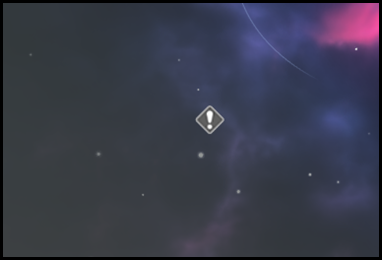
On the map I can see the marker where the battle happened.

See those beam weapons? Now that it's time to research tech, I’m going to pick:
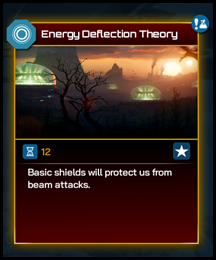
Then, I‘m going to issue an executive order:
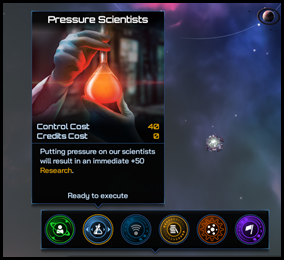
Pressure scientists.
Then, I’m going to be reminded about my policy of fast travel for 50% HP reduction…Oh, yeah. That didn’t help that battle.
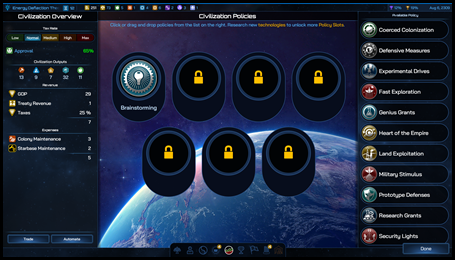
So I’m going to put in brainstorming instead.
And once I have that tech I’m going to design a ship from the Shipyard screen.

Let’s see if I can design a better ship than my Military Advisor. Here’s the one he provided:
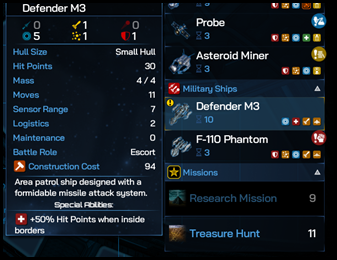
So on the ship designer screen I pick a template and equip 4 slots.
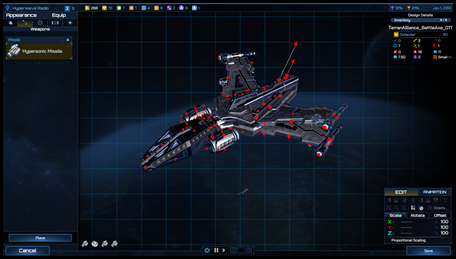
Now you can, if you want, make any cosmetic adjustments you like. But most people will just pick modules for their ships and leave cosmetic changes to others and then use the Metaverse feature to download those designs.
So I made a ship with 3 attack and a lot of defense.

So did I do a better job? My ship costs 1 Elerium to build, but as you may recall, I have Elerium. So it is a superior - albeit resource expensive - ship.
So let’s get to round two.

Those 3 missile launchers, even if terrible, still means 3 attacks per round.
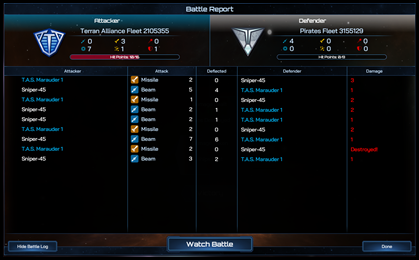
This is what I’m interested in:

So the Pirate Sniper had an attack of 3 with their beam, but my ship’s shields deflected 2 of it.
In huge battles, these advantages accumulate. Now I will sentry my ship in this area to keep it free from pirates so I can move colony ships and constructors safely through.
Biting me in the rear
Remember Maria? She was the one who had made and lost a fortune multiple times? Well..
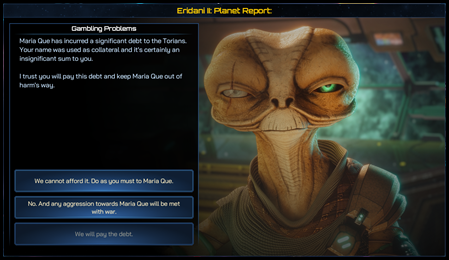
So now I can either let the Torians “collect” on her gambling debts OR I can risk a diplomatic problem with them. I have really no choice but to side with her because she is in charge of the super powerful magical planet, and I can’t afford to have her turn against me.
Conclusions
Mind you, we have only scratched the surface of the game. But hopefully this enough to get you started. I will be updating this post with answers to questions from the comments.
Good luck!

